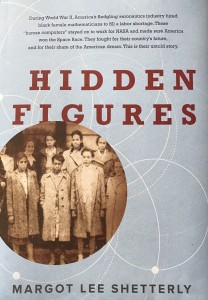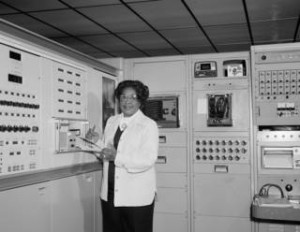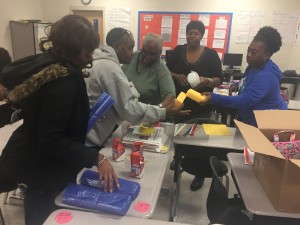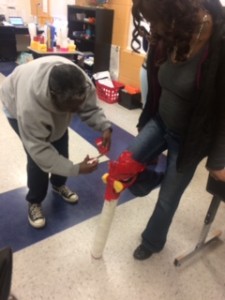 Hidden Figures, a best-selling read by Margot Lee Shetterly and an Oscar-nominated film, is changing how we understand the history of science, technology, engineering, and mathematics (STEM). Often, the stories of scientific discoveries and engineering feats omit the contributions of women or people of color and obscure the knowledge and experiences, both lay and professional, required to achieve STEM accomplishments. The usual discourse of STEM deemphasizes the social-historical context that creates the conditions for innovation of personnel (the who), process (the how), and product (the what).
Hidden Figures, a best-selling read by Margot Lee Shetterly and an Oscar-nominated film, is changing how we understand the history of science, technology, engineering, and mathematics (STEM). Often, the stories of scientific discoveries and engineering feats omit the contributions of women or people of color and obscure the knowledge and experiences, both lay and professional, required to achieve STEM accomplishments. The usual discourse of STEM deemphasizes the social-historical context that creates the conditions for innovation of personnel (the who), process (the how), and product (the what).
Shetterly provides an alternative narrative as she shines a light on the people, places, and purpose of STEM. She features African-American women in her historical storytelling of the US Space Race and the Civil Rights Movement. Her personal and professional stories of women, like Kathryn Johnson, Dorothy Vaughn, and Mary Jackson exemplify African-American women at work in NASA as mathematicians, computer scientists, and engineers. These women fully participate in the practices of STEM as they perform computational analysis, program mainframe computers, and conduct engineering tests. She explains how war, racial segregation, and sexism at home and in the workplace limited how African-American women participated in STEM and conversely, created a window of opportunity that amplified their contributions to STEM, in particular the rise of US Space Program.
Mary Jackson: Engineer and Inspiration

While Shetterly’s biographies of these women position them as pioneers of the space frontier, it is the story of Mary Jackson on the homefront that captured my attention and inspires my work. Mary Jackson was one of the first women to leave “West Computing” to join an engineering team as a specialized computer. Later, she completed advanced math and physics courses and achieved a promotion to engineer. Shetterly reports that Mary Jackson filled her days with professional and community service that increased awareness of and preparation for engineering among young girls and women and African-Americans.
In the chapter, Model Behavior (starting on page 193), Shetterly details how Mary Jackson spent time collaborating with her son, Levi, to design and build a car for the 1960 soap box derby race. Together, they read the manual to learn the specifications and constraints of this design challenge, ideated and sketched various designs of this vehicle, and built and tested several prototypes until Levi was ready to race. He won! Of course, Mary Jackson was filled with pride when her son became the first African-American to win the local soap box derby and advance to nationals in Ohio. But she had to be over the moon with her son’s answer to the local news reporter’s question, “What do you want to be when you grow up?” Levi responds, “I want to be an engineer like my mother.”
Mary Jackson’s life history resonates with me. As an engineering student and professional, I spent many hours working to diversify the STEM pipeline. Whether I was organizing professor-student mixers for science and engineering majors on campus, motivating elementary students’ curiosity with Lego models of the Mars Rover, or strategizing with corporate and academic partners, I was fully committed to diversifying who participates in STEM and the broadening notions what it means to participate in STEM. Now, as a STEM education researcher and practitioner, I am constantly seeking opportunities to infuse preK-12 learning with rich STEM activities and help parents, teachers, and community partners recognize STEM’s potential to transform our lives at local and global levels.
WGG Family STEM program captures the spirit of Mary Jackson
Last summer, bluknowledge embarked on a new venture that captures the essence of Mary Jackson’s spirit. We fortified our partnerships with the Hofstra University WISE Guys and Gals (WGG) research program and Savannah’s Parent University and Early Learning College to pilot a family program that connects parents and children through engineering learning experiences at home.
About every other month, we embed a WGG Family STEM session in an Early Learning College or Parent University event that happens on Saturday mornings at rotating local elementary or high schools. For two hours, participants who are parents or grandparents collaborate in pairs to design and test a solution to a given engineering design challenge. Guided by an in-person facilitator and the mobile WISEngineering platform, participants progress through the engineering design cycle. They (a) learn the specifications and constraints of their design challenge and engage in knowledge and skill-building activities. Then, they (b) ideate and build a prototype to meet their design challenge. Finally, they (c) test and plan for refinements to their designs. At the end of the session, we provide participants with a tablet and materials so they can engineer at home with their kids.
Participants use tablets to access the WISEngineering mobile platform and learn the knowledge and skills to perform the design challenge.
The Design Challenge Your challenge is to make a stable and comfortable model of a prosthetic leg that you will be able to walk at least 20 steps, and be able bear your weight without breaking. You will have limited time and materials for constructing your prosthetic leg.
Participants construct a prototype of a prosthetic leg using bubble wrap, sponges, ace bandages, and duct tape.
Participants use specific design criteria (in blue) to evaluate their prosthetic leg prototypes.
What’s next for our Mary Jacksons?
To date, we have recruited 8 African-American mothers and grandmothers of at least one middle-schooler for our pilot WGG Family STEM program. These Mary Jacksons have immersed themselves in the world of STEM as they learn about civil, biomedical and mechanical engineering careers. They have collaborated with fellow Mary Jacksons and their children and grandchildren to design and test prototypes for safe paths for transport, prosthetic limbs, and alternative vehicles (yes, hovercrafts!). Most importantly, they have been broadening what it means to participate in STEM as African-American women, parents, grandparents, and families.
While we are still early in our inquiry of the WGG Family STEM program, we seek to understand the social, material, and intellectual conditions that empower families to participate in STEM in their everyday lives — past, present, and future. We wonder how these engineering experiences
-
give rise to adult and youth curiosities of our natural, built, and technological worlds
-
shape the relationships and dialogue among family members at home
-
encourage lifelong and collaborative learning as adults and kids (re)learn STEM knowledge and practices with each other.
Like Shetterly and her “Hidden Figures” of NASA, we too, are inspired by these women of the WGG Family STEM program.







